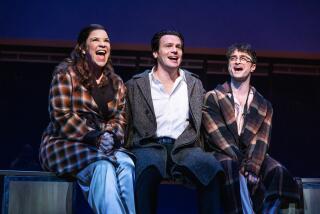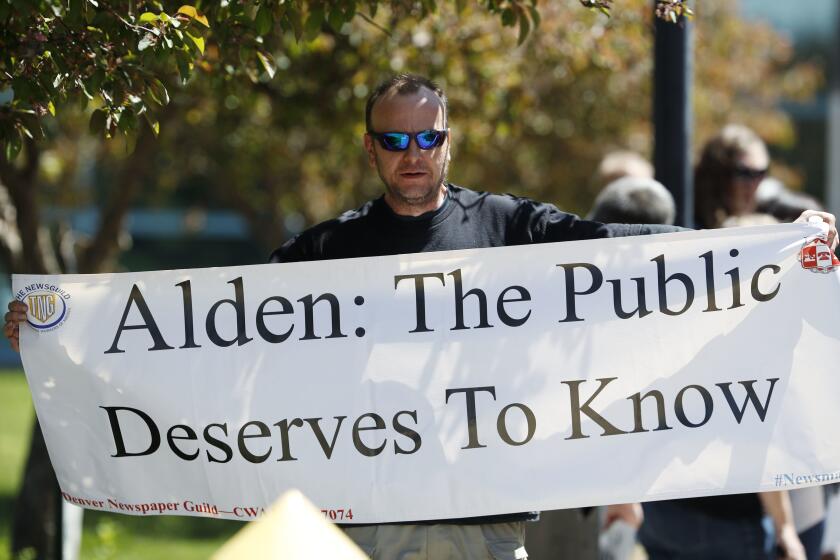Critic’s Notebook: My apprenticeship in the regional theater
Regional theater wasn’t a big turn-on for me when I was a theater student in the late 1980s, early 1990s. Off-Broadway was cool; off-off-Broadway was cooler. Those subscription-based behemoths scattered around the country like giant shopping malls sounded dorky to me.
My view of the world beyond the five boroughs of New York City was admittedly cramped back then. I didn’t realize that the theater that gave me my start, the Public Theater, was part of the very same nonprofit network my callow ignorance was prepared to completely write off. As the Public’s literary intern, reading scripts all day in the complex of offices shared by head honcho Joseph Papp and his wife, literary director Gail Merrifield Papp, I had a lot to learn. Had a fortune teller told me as I was plowing through the interminable slush pile that my professional values would be shaped in large part by my long apprenticeship in the “regionals,” I probably would have laughed and replied in my best Cherie from “Bus Stop” impersonation, “I don’t wanta go up to some Godforsaken ranch in Montana.”
As members of Theater Communications Group (TCG), which supports professional not-for-profit theaters in the U.S., gather for their national conference in Los Angeles this week, I’ve been reflecting on my career in the theater before I went over to the dark side and became a full-time critic. Mostly I’ve been thinking about how lucky I was to have been in such excellent nonprofit company early on in my development. I went from the Public Theater to the Yale Rep to the McCarter Theatre in a 12-year span that laid the groundwork for my understanding of how the American theater works. These years were fraught with challenges, frustrations and even moments of disillusionment. But I was surrounded by people whose attitude toward the nonprofit mission was that of a sacred trust. They understood they were not just adding to the repertory but that they were also feeding souls — their audiences’ and their own.
Memory has a tendency to gild the past, so let me acknowledge my longstanding problems with regional theater. Artists rely on institutions, but creativity loathes organizational prisons, even welcoming, money-granting ones. This conflict — between the essentially conservative nature of any institutional framework and the irrepressible waywardness of true originality — has bedeviled leaders with the most radical intentions. The situation is further complicated by a regional theater system that hasn’t always been organic to communities. In some places, theaters and theater audiences have found themselves in the situation of a couple trying to make the best of an arranged marriage. Artistic directors must somehow negotiate the gap between their own vision and the taste of those whose cold shoulder can run them out of business.
Such concerns may seem quaint by the standards of today when far too many nonprofit theaters have given themselves a commercial makeover, content to present themselves as a Broadway tryout or touring stop. A competitive pragmatism has increasingly come to replace the guiding nonprofit idealism I took for granted. Good work continues to be done, don’t get me wrong. But the thread connecting regional theaters to the movement from which they arose seems frayed. San Diego’s Old Globe has a penchant for wobbly commercial musicals, the Mark Taper Forum has dwindled in stature as the Ahmanson swells with traveling extravaganzas, Pasadena Playhouse is hobbled and bewildered after its financial crisis and La Jolla Playhouse has yet to define its post-Des McAnuff identity. Like so much else in our culture, the nonprofit theater has been on a downsizing and corporatizing trend.
The Papp years
Joseph Papp demonstrated to me firsthand how much pugnacity it takes to hold fast to one’s convictions. The big event of my time at the Public, beyond Kevin Kline’s “Hamlet” in 1990, was Papp’s war with the New York Times over David Hare’s “The Secret Rapture.” Frank Rich gave the play a positive review in London but was harshly critical of the Broadway production, and this slam from the Butcher of Broadway was seen to have undermined the show’s chances of survival.
Papp, who was nearing the end of his reign but who remained as implacable as King Lear, was furious. He had shortened the play’s run downtown so that Rich couldn’t review it before its planned move to Broadway. Rich’s power was formidable, and for Papp this quashing of serious work was the last straw. He treated his office as a war cabinet, storming in and out like a general gearing up for a great campaign. Hare wrote a stinging letter to Rich, and Papp, after releasing it to Variety, conscripted me to stand outside of the Public and hand deliver the screed to passersby.
I had seen the production at the Public and wasn’t sure I disagreed with Rich’s assessment. I remember sheepishly handing out the leaflets, as though they were coupons for something no one wanted to buy. But I understood the source of Papp’s anger, the perceived injustice over one reviewer’s stranglehold of power, and allowed myself to be swept up in the crusade.
Naively confused as I may have been, it was impossible for me not to recognize the theater-loving source of Papp’s passion. When I look back at the number of productions that were done during my internship, which was spread out over two seasons, I’m astonished by the level of activity. Much of the work wasn’t memorable. There were a few Shakespearean dogs (including a flying saucer-filled “Macbeth” that horribly misused Raul Julia) and some of the new plays had me unwittingly rehearsing an art I never suspected would become part of my future professional repertoire — snide panning.
But the energy of the place was unrelenting. Shows were constantly opening; readings and workshops were incessant. Tucked away in a corner with a script, I kept an eye out for the parade of famous people — Harry Belafonte one day, Tracey Ullman the next. Once, while immersed in some awful play, I looked up and there was Hare asking me what I was reading. (I acted as star struck as when Lucy meets Van Johnson on “I Love Lucy.”) I remained on high alert for the presence of my hero, Caryl Churchill, when her play “Ice Cream” was in previews with its curtain raiser “Hot Fudge.”
Papp kept this hive buzzing with his combativeness, tenacity, drive and, yes, egomania. His curiosity, often uninvited, would poke into everything, including on one embarrassing occasion a script his lowly intern was distractedly flipping through. Quantity over quality was the critique he was most vulnerable to as a producer, but in these days when so many nonprofit theaters have been rationing their resources for substantial drama while splurging on candied musicals, his outsize leadership model seems positively messianic.
After Papp
Lloyd Richards — who was in his last year as artistic director of the Yale Rep during my first year as a student at the Yale School of Drama, where he was also the dean — was the opposite of Papp. Jacketed in a gentlemanly reserve, Richards didn’t appear to be vying for the spotlight. Yale Rep was famous for its association with August Wilson, whose work Richards directed with unerring sensitivity. There was more to Richards’ legacy, but the theater’s profile had been raised by the way he had launched several plays of the Wilson cycle onto Broadway.
Stan Wojewodski Jr., who had been the artistic director of Baltimore’s Center Stage, was appointed Richards’ successor, and it was fascinating to observe the transition between two dedicated yet vastly different men of the theater. Wojewodski wanted to move Yale in a more adventurous, nonrealistic direction. He brought in Eric Overmyer (“On the Verge, or the Geography of Yearning”) and Suzan-Lori Parks (“The Death of the Last Black Man in the Whole Entire World” and “The America Play”). He had theatergoers wandering the Rep in an environmentally staged production of Maria Irene Fornés’ “Fefu and her Friends.” He presented classics that nonspecialists never heard of.
Old-time patrons found the experimentation heavy going. They would have preferred “As You Like It” to Christopher Marlowe’s “Edward the Second.” Athol Fugard and S.J. Perelman were appreciated, but George C. Wolfe’s “The Colored Museum” made heads spin. Avant-gardists, as is their wont, held aloof, approving the work more in theory than in practice. Wojewodski tried to tread a path that was respectful of the multicultural openness ushered in by his predecessor yet more curious about postmodern developments. Both leaders had received flak for their choices — one for being theatrically conservative, the other for being too exploratory.
What is remarkable to me in retrospect is the clarity of vision behind Richards’ and Wojewodski’s service to theater. Their sense of cultural innovation couldn’t have been more different, yet in both cases it was rooted in support of playwrights and their collaborators. These men weren’t battlers like Papp, but they knew that a degree of unpopularity was part and parcel of public life. You can’t please everyone — indeed, the only thing more vexatious than running a theater is running a newspaper. The takeaway from my experience as a script-reader, work-study stagehand and production dramaturge was the importance of having a core set of principles. Goals needn’t be uniform, but to survive the inevitable onslaught of an independent course, true conviction is required.
My longest stint was at the McCarter Theatre, which was and remains headed by Emily Mann, a director who is also a playwright. For six seasons, I was part of the theater’s literary and dramaturgy department, and her presence is the reason I stayed as long as I did. The author of “Still Life,” “Execution of Justice” and “Having Our Say,” Mann is a dramatist of deep political and social commitment, who, though in possession of a hearty sense of humor, understands that listening sometimes trumps laughing.
Susan Sontag used to decry the decline of seriousness in our age of rampant irony, and I confess that the unabashed gravity of Mann’s mission was a breath of fresh air to me. Fugard, who considered McCarter one of his American homes, has said that Mann’s body of work demonstrates “the central importance of theater to the psychic well-being and sanity of a society.” I couldn’t agree more.
During my McCarter years, I was also a theater critic at the Village Voice and Variety as well as an adjunct professor at New York University and the New School — a juggling act that was as enriching as it was logistically maddening. What nourished me during my tenure were the diverse writers — Marina Carr, Nilo Cruz, Dael Orlandersmith, Polly Pen — who were welcomed in all their singularity. Literature was a living thing and mattered accordingly. Working with Mann on her adaptation of Isaac Bashevis Singer’s novel “Meshugah” was less a job than a delightful busman’s holiday, a free-flowing conversation between a critic-dramaturge and a playwright-director on one of the 20th century’s most vivid writers.
I had wrongly assumed that McCarter’s Princeton location guaranteed an intellectual audience, but faculty and students made up only a small fraction of our attendance. The artistic staff faced the same programming conundrums as any large regional theater, the same tricky balancing act between critical standards and commercial appeal. I learned never to underestimate an audience’s ability to recognize good work — or to call you out on faltering efforts. But I also saw that theatergoers will follow when they are led with purpose, even when the result falls short of expectations.
This history gave me my bearings as a critic. It sharpened my judgment and made me appreciate the difficulty and tonic value of honest feedback. It also taught me that the art comes first; institutions and careers second. Spend enough time around theater people and their fanatical zeal rubs off.
This kind of passion will never go extinct, and I am encouraged by the ardor of so many leaders — Carey Perloff at A.C.T., Tony Taccone at Berkeley Rep, Oskar Eustis at the Public Theater, Tim Sanford at Playwrights Horizons and, closer to home, David Emmes and Martin Benson, who have just handed off the baton to Marc Masterson at South Coast Rep. But I can’t help feeling that the most urgent agenda item at the TCG conference should be about rededicating members to their nonprofit calling.
More to Read
The biggest entertainment stories
Get our big stories about Hollywood, film, television, music, arts, culture and more right in your inbox as soon as they publish.
You may occasionally receive promotional content from the Los Angeles Times.











